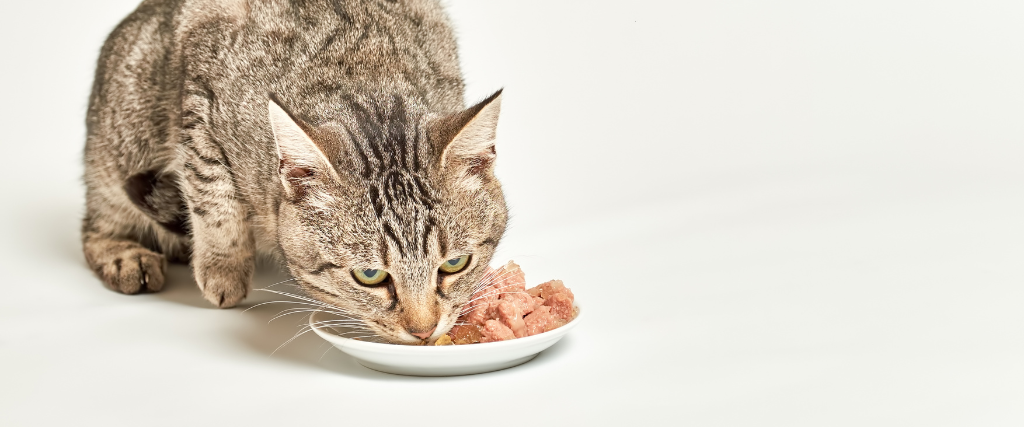As a cat owner, you naturally want what’s best for your beloved feline. That includes not only their emotional health and making sure they’re happy, but their physical health as well. At the root of a cat’s physical health are the nutrients they receive every day. Pet owners often question if they’re feeding their cats the right type of food and if they’re eating enough—especially since cats tend to be picky eaters. These are excellent questions that every cat owner should be asking to ensure the health and longevity of their feline companion.
Cat Nutritional Requirements
As with humans, food is energy for cats. They need it to fuel their bodies, grow, and survive, so if a cat isn’t eating enough or eating properly, medical problems will likely arise. Cats are obligate carnivores, which means they need an animal based high-protein diet to help them maintain muscle mass and a healthy physique. They cannot exist on plant-based protein alone. Cats can be prone to weight gain, so careful monitoring is essential, but they receive all the amino acids, minerals, and other nutrients directly from their diets. It is the recommendation of most veterinarians that felines are exposed to wet food from an early age, as studies show that wet foods are the healthier option for your cat. It’s not uncommon for cats over the age of six to transition to a wet food diet since they are picky eaters, whereas starting them off early on wet food offers consistency and stability in their diet.
Serving Sizes
Most cat foods have a recommended feeding schedule and serving size on the packaging, whether wet or dry food. These guidelines should be followed closely for a healthy, intact cat of average weight. However, there are two deviations.
Factors to consider regarding cat food serving sizes:
- If your cat is spayed or neutered – A cat’s metabolism is slower after a spay or neuter. Cat food packaging guidelines are intended for those that are still intact, so a spayed or neutered cat has lower energy and, therefore, a slower metabolism. When feeding your spayed or neutered cat, feed them 10-20% less than the recommendation.
- If your cat is overweight – If your cat is carrying some extra weight, your veterinarian might recommend a change in serving size or a prescription diet food to help shed those extra pounds. Always consult with your veterinarian before changing your cat’s diet to ensure the weight gain is enough to warrant a change to its eating. Purina Pet Nutrition offers additional insight into cat obesity and helping your cat lose weight.

Changing Nutritional Requirements
A cat’s nutritional requirements change throughout its life as they grow from a kitten into an adult cat, and eventually a senior cat. Just as human babies require multiple feedings a day since they need a higher caloric intake to keep up with their quick growth, kittens do as well. Kittens require more calcium, protein, and calories, and they have to be easy calories to digest. As kittens transition into adult cats at one year of age, they can be fed adult cat food. Around the age of 10, veterinarians recommend switching to senior cat food, especially if there are weight concerns. If there are no weight issues, sometimes the switch to senior food can wait until 12-13 years of age. This is based on the specific cat, any lab work they have done, and their overall health.
Signs of Poor Cat Nutrition
There are several signs of poor cat nutrition, most of which are visibly obvious to cat owners. However, cats are notorious for being stoic animals, meaning they work very hard to hide any signs of illness or not feeling well. For this reason, it’s important that owners are on the lookout for any changes in behavior or appearance.
Signs and symptoms of poor cat nutrition include:
- Dry and brittle coat
- Hair loss
- Weight loss
- Vomiting
- Diarrhea or constipation
Many of these symptoms also mimic signs of intestinal parasites, so it’s critical that you visit your veterinarian if any of these symptoms persist.
Food Allergies
Food allergies in cats are somewhat uncommon and easily identified by owners most of the time. Food allergies typically present as gastrointestinal distress, vomiting, and diarrhea. Sometimes, chronic ear infections are actually related to food allergies in cats and are most often associated with a meat protein allergy such as beef, chicken, or pork. A slow switch to salmon may help determine if one of those three proteins is causing the reaction.
You can learn more about cat nutrition from the World Small Animal Veterinary Association, WSAVA. If you have any questions or concerns about nutrition or any other aspect of your cat's health and well-being, please contact us to speak with one of our amazing team members.

